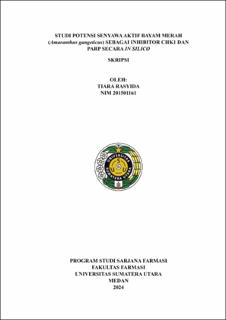| dc.description.abstract | Background: Breast cancer was the uncontrolled growth of abnormal cells in
breast tissue. Treatment of breast cancer with CHK1 and PARP inhibition caused
damage in all cell lines, triggering apoptosis. The use of red spinach as a naturalbased
treatment was still not optimal, so in silico testing was needed.
Objective: This study aimed to predict the potential of active compounds from red
spinach to inhibit CHK1 and PARP receptors and to meet pharmacokinetic
parameters as potential anti-cancer compounds in silico.
Methods: The study was conducted by validating the method using PyMOL,
performing molecular docking with Autodock Vina, and predicting
pharmacokinetics such as Human Intestinal Absorption (HIA), Volume Distribution
Steady State (VDSS), Fraction Unbound, CYP substrate and inhibitor, and total
clearance using the pkCSM website for CHK1 and PARP receptors.
Results: The results showed that the docking validation values for CHK1 and
PARP receptors were 1.5 Å and 1.088 Å. The docking simulation results identified
amino acid residues LEU 15, VAL 23, LEU 137, and SER 147 as binding pockets
for the CHK1 receptor, while amino acid residues TYR 907, SER 904, and GLY
863 were identified as binding pockets for the PARP receptor. The study revealed
that 13 red spinach compounds met the specified pharmacokinetic parameters. The
compound 3-(3,4-Dihydroxycinnamoyl) quinic acid was predicted to have
inhibitory activity against CHK1 and PARP and to meet pharmacokinetic activity
requirements, suggesting its potential in treating breast cancer in silico.
Conclusion: This study found that the active compounds of red spinach were
predicted to be utilized as inhibitors of CHK1 and PARP receptors. | en_US |


